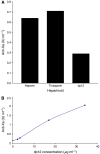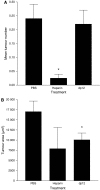Modulatory effects of heparin and short-length oligosaccharides of heparin on the metastasis and growth of LMD MDA-MB 231 breast cancer cells in vivo
- PMID: 17726466
- PMCID: PMC2360379
- DOI: 10.1038/sj.bjc.6603928
Modulatory effects of heparin and short-length oligosaccharides of heparin on the metastasis and growth of LMD MDA-MB 231 breast cancer cells in vivo
Abstract
Expression of the chemokine receptor CXCR4 allows breast cancer cells to migrate towards specific metastatic target sites which constitutively express CXCL12. In this study, we determined whether this interaction could be disrupted using short-chain length heparin oligosaccharides. Radioligand competition binding assays were performed using a range of heparin oligosaccharides to compete with polymeric heparin or heparan sulphate binding to I(125) CXCL12. Heparin dodecasaccharides were found to be the minimal chain length required to efficiently bind CXCL12 (71% inhibition; P<0.001). These oligosaccharides also significantly inhibited CXCL12-induced migration of CXCR4-expressing LMD MDA-MB 231 breast cancer cells. In addition, heparin dodecasaccharides were found to have less anticoagulant activity than either a smaller quantity of polymeric heparin or a similar amount of the low molecular weight heparin pharmaceutical product, Tinzaparin. When given subcutaneously in a SCID mouse model of human breast cancer, heparin dodecasaccharides had no effect on the number of lung metastases, but did however inhibit (P<0.05) tumour growth (lesion area) compared to control groups. In contrast, polymeric heparin significantly inhibited both the number (P<0.001) and area of metastases, suggesting a differing mechanism for the action of polymeric and heparin-derived oligosaccharides in the inhibition of tumour growth and metastases.
Figures






Similar articles
-
Inhibition of CXCR4-mediated breast cancer metastasis: a potential role for heparinoids?Clin Cancer Res. 2007 Mar 1;13(5):1562-70. doi: 10.1158/1078-0432.CCR-06-1987. Clin Cancer Res. 2007. PMID: 17332302
-
Multi-stage inhibition in breast cancer metastasis by orally active triple conjugate, LHTD4 (low molecular weight heparin-taurocholate-tetrameric deoxycholate).Biomaterials. 2016 Apr;86:56-67. doi: 10.1016/j.biomaterials.2016.01.058. Epub 2016 Feb 8. Biomaterials. 2016. PMID: 26890038
-
T140 analogs as CXCR4 antagonists identified as anti-metastatic agents in the treatment of breast cancer.FEBS Lett. 2003 Aug 28;550(1-3):79-83. doi: 10.1016/s0014-5793(03)00824-x. FEBS Lett. 2003. PMID: 12935890
-
Stromal cell-derived factor-1 and CXCR4 receptor interaction in tumor growth and metastasis of breast cancer.Biomed Pharmacother. 2006 Jul;60(6):273-6. doi: 10.1016/j.biopha.2006.06.004. Epub 2006 Jun 28. Biomed Pharmacother. 2006. PMID: 16828253 Review.
-
Functions of CXCL12 and CXCR4 in breast cancer.Cancer Lett. 2006 Jul 8;238(1):30-41. doi: 10.1016/j.canlet.2005.06.021. Epub 2005 Jul 25. Cancer Lett. 2006. PMID: 16046252 Review.
Cited by
-
Contribution of Heparan Sulphate Binding in CCL21-Mediated Migration of Breast Cancer Cells.Cancers (Basel). 2021 Jul 10;13(14):3462. doi: 10.3390/cancers13143462. Cancers (Basel). 2021. PMID: 34298676 Free PMC article.
-
Olfactomedin 4 suppresses prostate cancer cell growth and metastasis via negative interaction with cathepsin D and SDF-1.Carcinogenesis. 2011 Jul;32(7):986-94. doi: 10.1093/carcin/bgr065. Epub 2011 Apr 5. Carcinogenesis. 2011. PMID: 21470957 Free PMC article.
-
A structural analysis of glycosaminoglycans from lethal and nonlethal breast cancer tissues: toward a novel class of theragnostics for personalized medicine in oncology?OMICS. 2012 Mar;16(3):79-89. doi: 10.1089/omi.2011.0102. OMICS. 2012. PMID: 22401653 Free PMC article.
-
The antineoplastic effect of low-molecular-weight heparins - a literature review.Contemp Oncol (Pozn). 2013;17(1):6-13. doi: 10.5114/wo.2013.33766. Epub 2013 Mar 15. Contemp Oncol (Pozn). 2013. PMID: 23788954 Free PMC article.
-
Dabigatran antagonizes growth, cell-cycle progression, migration, and endothelial tube formation induced by thrombin in breast and glioblastoma cell lines.Cancer Med. 2016 Oct;5(10):2886-2898. doi: 10.1002/cam4.857. Epub 2016 Sep 7. Cancer Med. 2016. PMID: 27600331 Free PMC article.
References
-
- Ali S, Palmer AC, Banerjee B, Fritchley SJ, Kirby JA (2000) Examination of the function of RANTES, MIP-1alpha, and MIP-1beta following interaction with heparin-like glycosaminoglycans. J Biol Chem 275: 11721–11727 - PubMed
-
- Ali S, Robertson H, Wain JH, Isaacs JD, Malik G, Kirby JA (2005) A non-glycosaminoglycan-binding variant of CC chemokine ligand 7 (monocyte chemoattractant protein-3) antagonizes chemokine-mediated inflammation. J Immunol 175: 1257–1266 - PubMed
-
- Altundag K, Altundag O, Atik MA (2005) Heparin and CXCL12 dimerization. J Clin Oncol 23: 7248 - PubMed
-
- Amara A, Lorthioir O, Valenzuela A, Magerus A, Thelen M, Montes M, Virelizier JL, Delepierre M, Baleux F, Lortat-Jacob H, Arenzana-Seisdedos F (1999) Stromal cell-derived factor-1alpha associates with heparan sulfates through the first beta-strand of the chemokine. J Biol Chem 274: 23916–23925 - PubMed
-
- Azenshtein E, Luboshits G, Shina S, Neumark E, Shahbazian D, Weil M, Wigler N, Keydar I, Ben-Baruch A (2002) The CC chemokine RANTES in breast carcinoma progression: regulation of expression and potential mechanisms of promalignant activity. Cancer Res 62: 1093–1102 - PubMed
Publication types
MeSH terms
Substances
LinkOut - more resources
Full Text Sources
Medical
Miscellaneous

